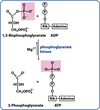Barrow: Carbohydrates Flashcards
What four things are carbohydrates useful for?
They are highly oxidisable (“high energy” H-atom associated electrons = major energy source for metabolism)
Storage of energy (starch in plants, glycogen in animals)
Structural and protective functions (plant cell walls, extracellular matrices around animal cells)
Cell-to-cell communication (eg: ABO blood groups)
How are carbohydrates stored long term (plants/animals)?
What structural and protective functions do carbs have?
As starch in plants, as glycogen in animals
Cell walls (plants), extracellular matrix (animals)
What is the name for six carbon sugars?
What are the three important ones in humans?
Hexoses
Glucose, galactose, fructose
Disaccharides: what is the covalent bond between the monosaccharides called?
What is an anomeric carbon? Which is it on glucose (and many others)? What two things make it important?
Glycosidic bond
Carbon on end of linear molecule if it wraps around on itself and joins together (carbon #1 on glucose) - stabilizes structure and it is the only residue that can be oxidised
Three important disaccharides in human biochemistry?
Maltose, lactose, and sucrose
What makes something a “reducing sugar”?
It has an anomeric carbon that is available for oxidation
Do we get maltose from the diet?
What is it a breakdown product of? Where is it therefore often found?
What two monosaccharides is it made from? Which type of glycosidic bond is it?
Not much
Starch (found in beer)
Alpha-D-Glucose and Beta-D-Glucose (Alpha 1,4)

Lactose: is it termed a reducing sugar?
What monosaccharides make it up?
Yes
Galactose and glucose (NB: remember the lactose part of galactose minus the g of glucose)

Common table sugar: what is the actual name?
How much % of dietary carbs does it make up?
What makes it? Also, is it a reducing sugar? Why/why not?
Sucrose
25%
Plants. No (no free anomeric C-1)

What is the name of molecule with lots of monosaccharides?
How are they classified? [4]
Polysaccharides
Identity of units (homopolysaccharide = one type of monomer, hetero = 2+ types), amount of branching, length of chains, and type of linkages
Starch
Made up of which monomers?
What are the names of the two polymers that make it up? How much of each are there? How do they differ?
Glucose
Amylose (20-25%) and Amylopectin (75-80%), former are linear with only alpha-1,4 linkages, whereas latter are also branched (every 24-30 residues) via alpha-1,6 linkages
Starch
What structure does it tend to form when the two components come together?
What does “non-reducing end” essentially mean?
Many non-reducing ends, few reducing ends, and believed to form alpha helices and a structure as seen in picture
Essentially just a nomenclature thing - it’s the end where stuff tends to get added on to.

Glycogen
How is glucose linked in this animal storage system?
Where is most of glycogen stored? How much is “most”? What different functions is it used for in these two places?
Alpha-1,4 linear with branches (alpha-1,6) every 8 to 12 residues
90% in liver (replenishes blood glucose) and skeletal muscles (catabolism produces ATP for contraction)
What three major reasons do we store glucose in glycogen?
Compactness (good for storage), many non-reducing ends (so can be formed/degraded quickly as needed), and it is a hydrated gel (not in solution = osmotically inactive = kept in cell for far lower energy cost)
What is the name of the proteins with carbohydrates covalently attached?
Glycoproteins
Glycoproteins
What are they?
Where are they commonly found?
What do the attached bits potentially do? [4]
proteins with carbohydrates covalently attached
Often attached to extracellular proteins
Increases protein solubility, influences folding/conformation, protects proteins from degradation, and acts as communication between cells.
Glycosaminoglycans
What did they used to be called? Where are they often found?
What are they?
Mucopolysaccharides (mucus and synovial fluid around joints)
Unbranched polymers made from repeating units of hexuronic acid and amino-sugar (sugar molecule with nitrogen on it)
Proteoglycans
What are they? What composes the majority of their structure?
How are they formed?
Where are they often found (in terms of cell and tissue)?
Protein + carbs (carbs dominant)
Formed from glycosaminoglycans attaching to proteins
Found on surface of cells or within extracellular matrix (so common part of connective tissue)
Glycoproteins
These are similar to proteoglycans. What’s the difference?
Where are they usually found? Where else can they be found?
Protein is dominant over carb
Usually found on plasma membrane and in ECM. Also: in blood and within cells in secretory system. Occasionally: cytoplasmic/nuclear proteins are glycoproteins
What are mucopolysaccharidoses?
What happens?
Genetic disorders caused by absence or malfunction of glycosaminoglycan breakdown enzymes
Over time, GAGs build up in connective tissue, blood, and cells -> damages cellular architecture and function -> dementia, heart and other endothelial structures (builds up between endothelial cells), stunted bones, joints inflamed/damaged
Can you remember the name of any mucopolysaccharidoses?
Hurler, Scheie, Hunter, and Sanfillipo syndromes
Hurler Syndrome: describe it
Mucopolysaccharidose leading to developmental defects (stop growing at 4, death by 10), clouding/degradation of cornea, arterial wall thickening, dementia (caused by build up of CSF and enlarged ventricles)
Digestion of carbohydrates. Run through what happens in…
… mouth…
… stomach…
… duodenum…
… jejunum [4]…
Main products?
Mouth: salivary amylase hydrolyses alpha-1,4 bonds
Stomach: nothing
Duodenum: pancreatic amylase (as mouth)
Jejunum: mucosal sell surface enzymes (isomaltase hydrolyses a-1,6; glucoamylase removes glucose from non-reducing ends; sucrase hydrolyses sucrose; lactase hydrolyses lactose)
Main products: glucose, galactose, fructose
Walk through absorption of glucose from the intestinal lumen into the blood
Glucose and Na+ symported into cell (driven by high EC Na+)
Sodium kept low (and potassium high) by acive pumping on basal surface of cell
Glucose (GLUT2) transporter allows glucose to pass into blood on basal side
































